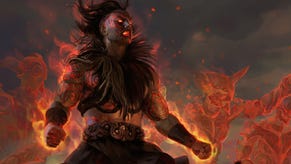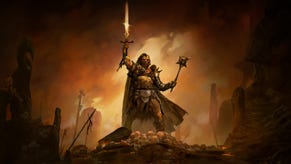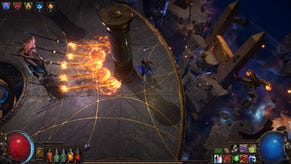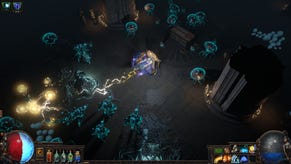Impressions: Path Of Exile Beta
But no jetpacks
The entire internet has filled up with discussions, videos and arguments about the Diablo III beta this week. Just to even things out, I’m reserving this little corner to talk about a different line of hacking and looting RPG though. Path of Exile, which will be free to play at launch, is also in a playable beta state at the moment and I’ve been walking its desolate beaches with naught but driftwood to protect me. I’ve brought back thoughts.
Oh look, there’s an elephant in the room. Let’s introduce ourselves.
“Hello!”
“To play Path of Exile you have to be online and you can’t pause, even when adventuring solo.”
That was an abrupt yet informative elephant, wasn’t it? Let’s get this out of the way then.
Although Grinding Gear aren’t calling their game an MMORPG, you’ll always be connected to a server with other players. In towns, you can see them, chat with them, trade with them and join up with them. Once you go into the randomly generated wilderness, where the bulk of the game takes place, if you left alone, you remain alone. But you’re still connected and you’ll still be able to see people’s trade offers and requests.
During my short time with the beta I’ve been playing solo, although I’ve had plenty of tips from the very helpful community. If I play the full game, I’ll probably play solo, although the extensive PVP features sound like an interesting way to test out and challenge different character builds. The game seems to expect me to want to form or join a party though. That’s fine because I can ignore it and do things my own way, but I know plenty of people would like to take things one step further and play the entire game offline. The client-server structure is the reason given for not having a solo mode, so I don’t know how possible it is, but I’d be delighted to see support for offline characters in the final release. I don’t care if an offline character is doomed to be offline forever; if that’s the only option, fine. He’ll miss out on trading and partying but he’ll still have loot to collect and monsters to bash.
So we’re already linked in some terrible way to Diablo III, which I was trying to escape from. I originally decided I’d write about Path of Exile without constant references back to Diablo but that’s not going to be possible and it wouldn’t be particularly helpful either. Grinding Gear haven’t shied from alluding to Diablo in the game so it wouldn’t be sensible to talk about it without doing exactly the same thing. Let’s get out of the way then: Path of Exile is a lot like Diablo. From what I’d seen before I started playing, I was expecting an experience closer to Blizzard’s first foray into demonland, with the emphasis on a single underground dungeon and a quest into its depths. As is often the case I was completely wrong and it turns out to be much more like Diablo II.
I’ll get the similarities out of the way first before I move on to the differences, which are harder to discern but far more interesting.
First of all, there are the locations. They are mostly barren areas inextricably strewn with chests, barrels and monsters. Act one starts with the player washed up on a beach in the terribly unpleasant land of Wraeclast. There was a shipwreck and now the beach is full of bodies and the bodies are standing up and trying to eat the survivors. That’s a good thing because it means you can clobber them for experience and loot, and that’s why you’re here in the first place. Yes, there’s a plot about exiles being sent to a forsaken land, struggling to survive there, but really it’s all about filling up experience bars and finding nifty equipment.
When you create your character you will have to pick a class, although the entire skill tree is open to all six classes. The classes defer specialisms rather than tying the player to a distinct grouping of abilities, so if you want to create a dual-wielding wizardy sort, it should be possible. I went for the duellist because he reminded me of Inigo Montaya. The character selection screen is the first big clue that Grinding Gear aren’t so much trying to turn their backs on the Diablo comparisons as flaunting them.
Characters stand in a semicircle and when selected, step forwards so you can have a better look. It’s almost exactly like my memories of Diablo 2 but with more characters. I’m going to say this now – pointing out similarities is not a criticism. I like Diablo, the vast majority of people playing this like Diablo, that’s why we’re here. If it turned out to be nothing more than a reskin, then there’d be reason for disgruntlement. As it is, and as I’ll make clear, there are differences enough.
But what else is the same?
Identifying items is, town portals are, the stash is, the surly merchant and the conversation system both are. The conversation system might seem like a small thing to point out, but it’s identical in its presentation, except there’s no voice acting here. Holding down alt to find items is the same, champion monsters are the same, right clicking to activate a skill is the same, although there are a lot more skills, many of them passive.
Waypoints are the same too. Each new area has one, you find it, you can teleport back and forth. It’s useful and given just how packed with respawning enemies those areas become, I wouldn’t want to play without them. However, it was the waypoints, oddly, that almost made me crumble and admit to myself that I was playing Diablo II but with fancier graphics. I was using potions in the same way, slugging them down in the middle of a fight, I had the map overlay in the middle of my screen in the same way, I was even hitting the same keys to open up the various windows. Even the enemies for that opening area are similar, with zombies replaced by zombies and quill rats being replaced by weird crustaceans that shoot sand and grit out of their backsides, or maybe their faces. I’m not an expert on make-believe crab biology.
Instead of throwing up my hands and reinstalling Diablo II though, I furrowed my brow and persisted, trying to get past the surface appearance and mechanics to see if there was anything new underneath. And guess what? There is, there really is.
I’ve already mentioned the skill system, which I like the idea of, but I haven’t built enough characters or gone deep enough to explore it properly yet. Being able to combine skills every which way is, I think, a good thing. It means individuals will feel individual and, for the multiplayers among you, parties will be made up of varied groups. It’s not a case of a character simply being a duellist, he’ll be a specific duellist, with his own way of getting things done. All that is reflected in how characters appear in the game. That’s one of the things they’ve really sold me on. I like dressing up.
Seeing my duellist actually wearing them is part of the fun of finding increasingly robust hats and trousers. Path of Exile handles this particularly well by starting players off with shields that are nothing more than planks of wrecked ships and driftwood clubs. When I found a rusted helmet, it completed the look perfectly. I look forward to visually progressing from this ramshackle start to become a hero clad in legendary armour, wielding a sword that glows with divine righteousness and fury. Yes, I want all the numbers on my character screen to go higher and higher as well, but visual representation is important to me in RPGs.
The biggest difference I’ve come across so far is in the implementation of items though, and items, being loot, are at the foundation of the game. There are different tiers, just as in Diablo, but it’s the socketing that changes things. Yes, socketing isn’t new in itself, but it goes much further in Path of Exile, or at least that’s my impression at this early stage. The primary reason is that modifications, to drop into any free sockets on an item, drop far more often than in Diablo II and they seem to alter weapons in more dramatic ways. Within a couple of hours of starting, I had three different weapons, all modified with at least one plugin, and all with different uses. One concentrated on pure power, one was fast and frightful, and the other was a two-handed beast of a sword dripping with poison. They often have abilities activated as you would normally activate character skills, which makes me think much more actively about what I've got equipped.
Two swords, even if they’re both standard in every other way, might have a different combination of coloured sockets in them. That means it might be worth keeping both, seeing what shows up later, and then altering the swords in different ways, thereby ending up with two unique items. Same goes for armour. In Diablo II, I found myself sticking with a core set of equipment, switching it out when I found a better magic item. Here, I can see myself changing my tactics more and having a few alternative loadouts. If I don't feel great about other things in the game, let it be known that I feel fantastic about the loot and in many ways, that is the game.
It all goes back to the social nature of the game as well. Trading is strongly encouraged and because characters are much more user-defined, you might find someone who really wants a swift, stabby shard that seems useless to you, maybe because it would fit well as an off-hand weapon or because his/her character does critical damage so frequently that it’s worthwhile.
For me, wanting to be a hermitty exile and go through the game solo, the social stuff is unnecessary. Being able to trade so easily is attractive, I’ll concede that, but I don’t really want a party around me. That said, I like Path of Exile a lot. The world is interesting, even though the individual areas can be a little bland at the moment, and levelling and gearing up already promises to be frighteningly addictive. While it won’t be as slick as Diablo III and I wish the camera was zoomed out further, it does look good. On top of that, none of it will ever cost you a penny unless you choose to buy cosmetic items and gestures, or want to transfer characters across accounts.
It certainly doesn’t feel like a bargain basement Diablo clone, which is precisely what might be expected from a free to play ARPG. The complexity of the skill and item systems alone make it worth a dabble, and despite my mild annoyances, I’ll definitely be playing a lot more. But I can already feel myself being distracted by Grim Dawn and I’ve not even had a go on that yet.












